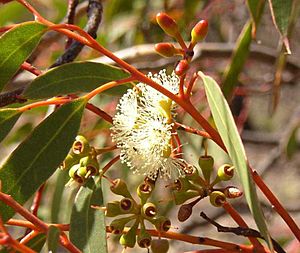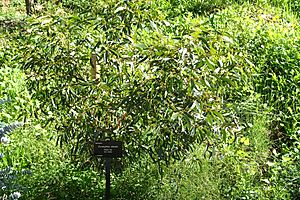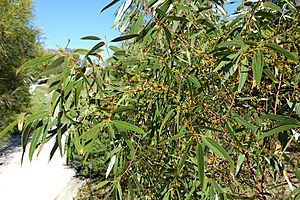Red mallee facts for kids
Quick facts for kids Red mallee |
|
|---|---|
 |
|
| Scientific classification | |
| Genus: |
Eucalyptus
|
| Species: |
oleosa
|
| Synonyms | |
|
|

The Eucalyptus oleosa, often called the red mallee, is a special type of tree or shrub found in Australia. It's also known by other names like glossy-leaved red mallee, acorn mallee, oil mallee, or giant mallee. A "mallee" is a type of eucalyptus that grows with many stems from a large underground root.
People used to collect the leaves of this plant to make a type of eucalyptus oil. This oil was used for many things, like medicines. However, another type of eucalyptus, Eucalyptus cneorifolia, is now used more often. It has more oil in its new leaves.
Contents
What Does the Red Mallee Look Like?
The red mallee is a tree or a multi-stemmed shrub. It usually grows to be about 11 to 12 meters (36 to 39 feet) tall. The bark at the bottom of the tree is rough and brown. Higher up, the bark becomes smooth and grey.
This plant blooms, or flowers, in November and December. It produces pretty yellow flowers. The adult leaves are shiny and green. They are shaped like a narrow spear, about 13 centimeters (5 inches) long and 2 centimeters (0.75 inches) wide.
The flowers grow in groups of seven to eleven. These groups are found where the leaves meet the stem, which is called the leaf axil. The flower buds are smooth and about 1 centimeter (0.4 inches) long. They are shaped like a cone or a cylinder.
After the flowers, the plant grows round fruits. These fruits are about 0.7 centimeters (0.3 inches) wide. Inside, there are dark brown seeds that are about 0.2 centimeters (0.08 inches) long.
How Was it Named?
The Eucalyptus oleosa was first officially described in 1856. A Dutch scientist named Friedrich Anton Wilhelm Miquel wrote about it. He used notes from another scientist, Ferdinand von Mueller.
The name oleosa comes from a Latin word meaning "full of oil" or "oily". This name was chosen because the adult leaves of this plant contain a lot of essential oils.
This species is similar to another eucalyptus called E. socialis. For a while, people sometimes confused them. But you can easily tell Eucalyptus oleosa apart because its leaves are shiny and green.
Scientists have also found different types, or subspecies, of Eucalyptus oleosa. Four of these are widely recognized:
- Eucalyptus oleosa subsp. ampliata: This type has wide leaves, smooth bud caps, and fairly large fruits.
- Eucalyptus oleosa subsp. corvina: This one has slightly bumpy bud caps, short flower stems, and oval fruits.
- Eucalyptus oleosa subsp. cylindroidea: It has slightly bumpy bud caps, longer flower stems, and cylinder-shaped fruits.
- Eucalyptus oleosa subsp. oleosa: This is the original type. Its bud cap is narrower than the base of the flower where they join.
Where Does the Red Mallee Grow?
The red mallee is one of the most common mallee plants in Australia. You can find it in many places. In Western Australia, it grows on hills, sandy plains, and in gravel pits. It likes sandy or loamy soils, often over limestone.
Its range stretches across southern and central South Australia. It also grows in northern and eastern Victoria and southwestern New South Wales. It often grows in groups with other mallee shrubs on red sandy areas.
The red mallee is part of different plant groups. One group is called the western mallee subgroup. Here, it grows with other eucalypts like Eucalyptus eremophila and Eucalyptus incrassata. The plants growing underneath are mostly shrubs like Melaleuca and Acacia.
Another group is the chenopod mallee subgroup. In this group, E. oleosa grows with trees like Eucalyptus gracilis. The plants under them include species like Maireana and Sclerolaena.
Uses of the Red Mallee
Besides making Eucalyptus oil, the red mallee is also good for producing a lot of plant material, called biomass. It can produce about 10 to 20 tons of biomass per hectare each year.
In farming areas, this tree is very helpful. It can help reduce salinity (saltiness) in the soil. It also provides shade for farm animals and acts as a windbreak. This helps to reduce erosion of the soil.
You can also buy the seeds of the red mallee to grow it in your garden. The seeds sprout easily, and the plant is very tough. It can handle salty soil, dry weather (drought), and even frost. It can be used as a hedge, a shade tree, or for honey production.
See also
 In Spanish: Eucalyptus oleosa para niños
In Spanish: Eucalyptus oleosa para niños



